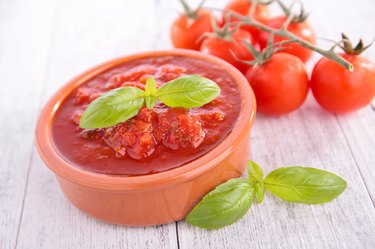
Tomato sauce does wonders for the flavor of a plate of spaghetti or a slice of pizza, but the red sauce also provides essential nutrients. A cup of tomato sauce contains a quarter of your recommended daily intake of vitamin A and fulfills half of your daily need for vitamin C. Tomatoes are also naturally rich in the antioxidant lycopene. Depending on how it's prepared, tomato sauce also provides fiber.
Versatility
Video of the Day
Tomato sauce has a place in cuisines from all over the world. You'll find it in Italian pasta dishes, Mexican enchilada sauce, Indian curries and American meat loaf. Tomatoes are the second most-consumed vegetable and the third largest vegetable cash crop in the U.S., according to U.S. Department of Agriculture figures, and those figures include tomato sauce. If you need something quick for dinner and have tomato sauce on hand, you have one of the building blocks of a tasty and healthful skillet meal, soup, pizza or casserole.
Video of the Day
Availability and Cost
Tomato sauce offers you good economic value as well as good nutrition. The flavorful sauce typically costs less per serving than a comparable cream-based or meat-based sauce because its main ingredient costs relatively little. You'll find tomato sauce in its pure form or mixed with other vegetables as a premade pasta sauce in supermarkets, corner groceries and even gas station markets. Ubiquitous and inexpensive, tomato sauce has earned its status as a kitchen staple.
Vitamins and Minerals
Whether whole or as a sauce, tomatoes are rich in vitamins A, C and K. Your body needs vitamin A for maintaining low-light vision and for building connective tissues under the skin. Vitamin C fills multiple roles within your body, including keeping your teeth and gums healthy, speeding wound healing, metabolizing fats, and absorbing other vitamins and minerals. Vitamin K affects blood clotting. The potassium and manganese in tomatoes help your body build stronger bones and stave off the muscle cramps you could get from low levels of these minerals.
Fiber
A cup of tomato sauce contains as much as 6 grams of fiber. While fiber varies from brand to brand and style to style -- chunky tomato sauces contain more fiber than strained sauces -- tomato sauces do add to your daily fiber intake. You may already be familiar with fiber's ability to aid digestion and keep you regular, but fiber also helps control your blood sugar levels and may lower your levels of blood cholesterol. Tomato sauce combines well with whole-wheat pasta or vegetable-laden pizza to get extra fiber in your daily diet.
Calories
Tomato sauce contains about 100 calories per cup but adds a great deal of flavor to food. Compared with cream-based sauces that contain many times as many calories per cup, tomato sauce is a lean and nutritious option. Pure tomato sauce contains no fat and approximately 20 grams of carbohydrates per cup, so tomato sauce fits easily into a low-fat diet and fairly well into a low-carbohydrate plan.
Lycopene
The health benefits of antioxidants depend on the plant-based chemicals' ability to "prevent free radical induced tissue damage," as Dr. Ian S. Young wrote in his 2001 "Journal of Clinical Pathology" article on the effects of antioxidants on health. Lycopene, vitamin A and vitamin C all serve as antioxidants that protect your body's tissues from damage. While scientific evidence to support the health benefits of taking lycopene supplements remains limited, tomato sauce contains lycopene and vitamins in a delicious form. Enjoy the taste of tomato sauce while reaping the potential benefits of antioxidants.
- RecipeTips.com: Nutrition Information for Tomato Products, Canned, Sauce
- Centers for Disease Control and Prevention: Vegetable of the Month: Tomato
- KidsHealth: Vitamins
- "British Journal of Nutrition"; Tomato Juice Decreases LDL Cholesterol Levels and Increases LDL Resistance to Oxidation; Marja-Leena Silaste, et al.; 2007
- "Journal of Clinical Pathology"; Antioxidants in Health and Disease; I.S. Young, et al.; 2001
- USDA Economic Research Service: Vegetables and Melons: Questions and Answers